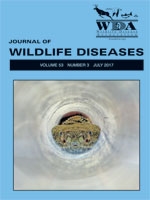Seventy-two free-ranging American martens (Martes americana) in Michigan, US were immobilized using isoflurane from 2011 to 2015. In total, 129 anesthetic procedures were performed with no mortalities. Hypothermia and hyperthermia were the most common anesthetic complications, and the mean rectal temperatures were significantly higher during summer than in winter. Dental abnormalities were common; the majority of abnormal findings were broken or discolored teeth attributed to previous dental trauma and were not trap-induced. Blood (n=72) was analyzed from 53 martens for venous blood gas, lactate, hematocrit, and/or selected serum biochemistry analytes. Lactate concentration was measured by two different devices (VetScan i-STAT 1 and Lactate Plus) and compared for clinical agreement for 26 samples. Both methods for lactate measurement provided statistically similar results. Using domestic feline reference ranges, the acid-base status and relative arterial oxygen saturation of anesthetized martens in this study were normal as determined by blood pH and pulse oximetry, respectively. Serum biochemistry parameters, multiple environmental parameters, and marten-specific attributes were evaluated for their influence on lactate in American martens using linear regression and an information-theoretic approach with model averaging. Blood urea nitrogen was in all of the top models and was positively related to lactate (β=0.02, 95% confidence interval: 0.00–0.04). Initial body temperature, ambient temperature, and time from trap discovery until immobilization of martens were informative predictors for lactate level. Recommendations for the live-trapping and isoflurane anesthesia of free-ranging martens include using caution during warmer summer months, minimizing disturbance prior to induction, monitoring lactate in addition to vital rates, and being prepared to prevent or treat both hypothermia and hyperthermia during any time of year.
How to translate text using browser tools
1 July 2017
EFFECTS OF LIVE-TRAPPING AND ISOFLURANE ANESTHESIA ON FREE-RANGING AMERICAN MARTENS (MARTES AMERICANA)
Maria C. Spriggs,
Lisa I. Muller,
Paul Keenlance,
Robert L. Sanders,
Jill C. Witt,
Debra L. Miller
ACCESS THE FULL ARTICLE

Journal of Wildlife Diseases
Vol. 53 • No. 3
July 2017
Vol. 53 • No. 3
July 2017
American Marten
Anesthesia
blood gas
capture
handling
isoflurane
lactate




